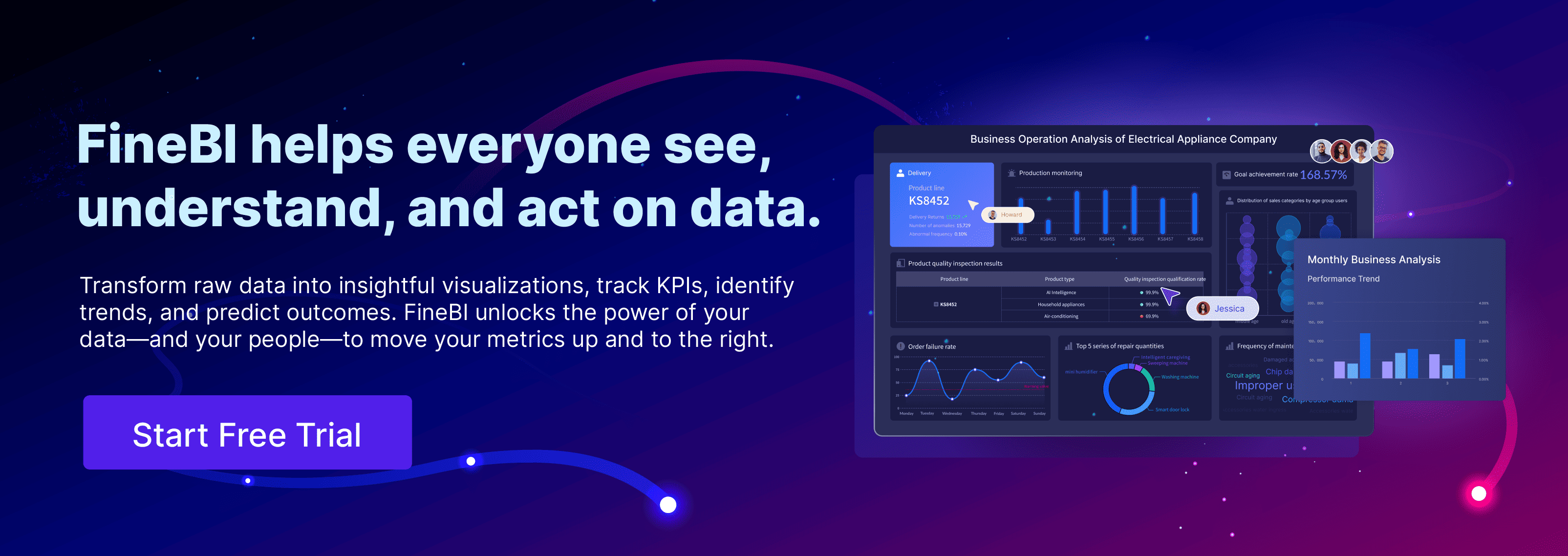Retail intelligence means using business intelligence tools and data analysis to help you understand and improve every part of your retail operations. You use retail intelligence to collect, process, and interpret data from sales, customers, and inventory so you can make better decisions. This approach gives you clear insights into what works and what needs improvement.
You rely on data-driven decision-making to stay competitive. Retailers who use data and business intelligence see stronger results. They notice higher efficiency, better inventory management, and more personalized customer experiences. For example, you can spot inefficiencies, monitor staff performance, and track stock in real time. These actions help you avoid overstocking or running out of products.
FineBI stands out as a business intelligence platform that empowers you to unify data from different sources. It helps you analyze trends and share insights quickly. With FineBI, you make data-driven decisions that drive retail growth and set your business apart from the competition.
Retail Intelligence Overview
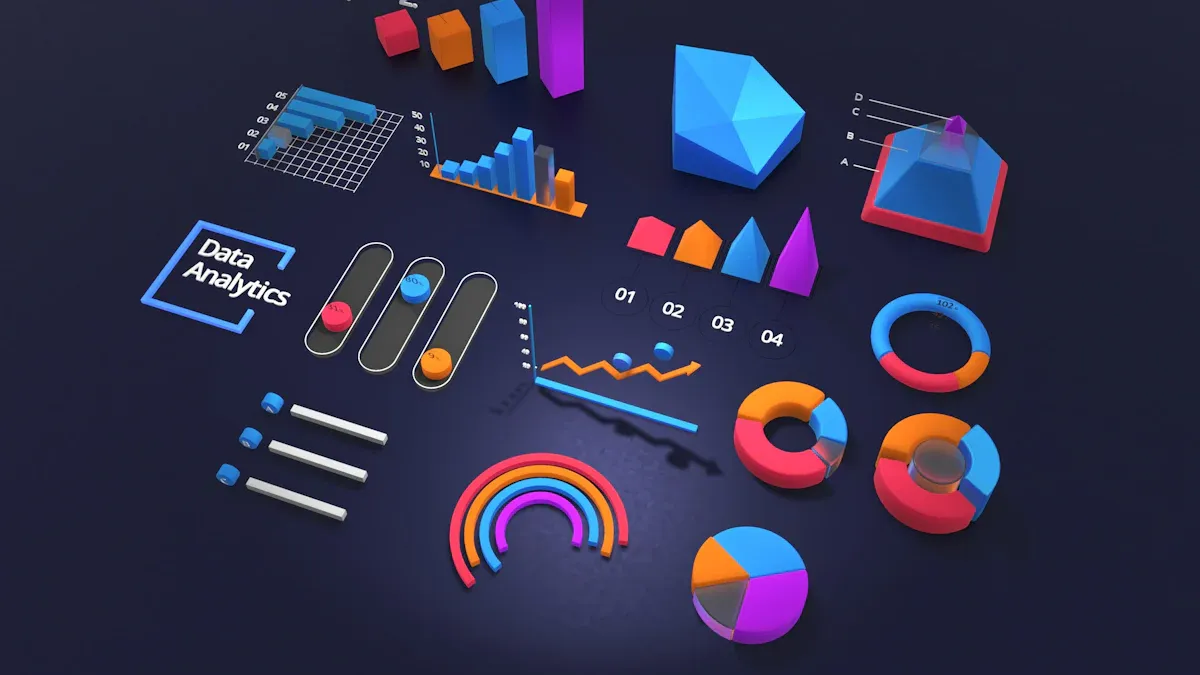
What Is Retail Intelligence
Retail intelligence gives you the power to understand and improve every aspect of your retail business. You use retail intelligence to collect, analyze, and interpret data from many sources, such as sales transactions, customer interactions, and inventory levels. This approach helps you make smarter decisions and adapt quickly to changes in the market.
At its core, retail intelligence combines several important components and technologies:
- Data collection from sales, customer behavior, and store operations.
- Data analysis using advanced tools to find patterns and trends.
- Data analytics platforms that bring together information from different business areas for unified insights.
- Artificial intelligence to predict future trends and support strategic planning.
- Machine learning to improve performance by learning from past data.
- Customer relationship management tools to track and enhance customer loyalty.
- Sensors and counters to monitor foot traffic and in-store behavior.
You rely on retail intelligence to turn raw data into actionable insights. These insights help you understand what products sell best, which promotions attract more customers, and how to optimize your store layout. With retail business intelligence, you move beyond guesswork and base your decisions on facts.
FineBI serves as a strong example of a retail intelligence platform. It connects to a wide range of data sources, including big data platforms and SQL databases. You can create visualizations by dragging and dropping, making it easy to explore your data. FineBI also supports collaboration, allowing your team to share dashboards and reports for better teamwork. The platform recommends the best visual effects based on your data, helping you analyze information faster and more effectively.
| Feature/Functionality | Description |
|---|---|
| Data Management | FineBI connects with over 30 big data platforms and SQL data sources. |
| Data Visualization | You can create visualizations by dragging and dropping, making analysis intuitive. |
| Data Collaboration and Sharing | FineBI offers collaboration, data sharing, and dashboard sharing for effective teamwork. |
| Dashboard Function | It merges analytic data into unified reports for monitoring key indicators. |
| User-Centric Analysis | The platform recommends visual effects based on your selected data. |
| Extensive Analysis Capabilities | FineBI recognizes dimensions and indicators for various calculations. |
| Self-Service BI Tool | Team members can independently analyze data, supporting faster decision-making. |
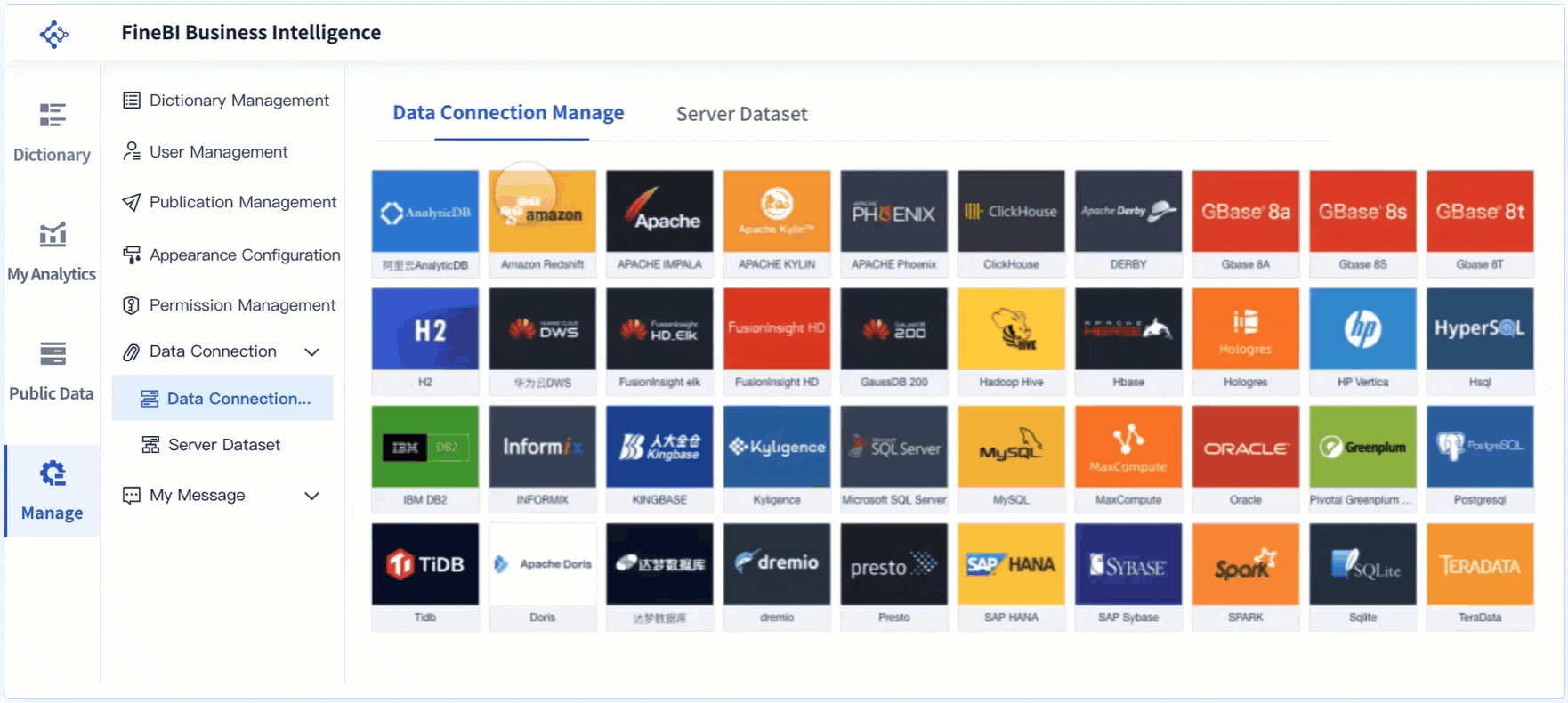
Why Retail Intelligence Matters
Retail intelligence has changed the way you run your retail business. In the past, you might have relied on historical data or intuition to make decisions. Now, you can access real-time insights that help you respond quickly to market changes and customer needs.
You see several key benefits from using retail intelligence:
- You shift from intuition-based decisions to data-driven strategies, which leads to better inventory allocation and risk management.
- You optimize your supply chain and improve operational efficiency by using customer intelligence platforms that integrate data from multiple sources.
- You gain a complete view of customer behavior, allowing you to personalize marketing and improve customer experiences.
- You use promotional intelligence to design targeted campaigns based on consumer behavior analysis.
- You monitor competitors’ strategies and adjust your own pricing and promotions to stay competitive.
- You segment customers based on preferences, which helps you deliver personalized offers and increase repeat purchases.
- You analyze purchase histories to stay ahead of consumer trends and tailor your product recommendations.
The retail industry has seen major changes in recent years. You face growing consumer expectations, rapid technology adoption, and the need for real-time pricing and inventory management. Retail business intelligence helps you meet these challenges by providing the insights you need to make informed decisions.
| Trend | Description |
|---|---|
| Personalized Customer Experiences | You create tailored shopping experiences for each customer. |
| Real-Time Pricing Adjustments | You adjust prices instantly to match market changes. |
| Optimized Inventory Management | You manage stock levels efficiently, reducing waste and improving sales. |
| Enhanced Supply Chain Efficiency | You streamline supply chain operations for cost savings. |
| Improved Employee Productivity | You use data to boost workforce efficiency and performance. |
| Growing Consumer Expectations | You meet higher demands for better customer experiences. |
| Technology Adoption | You invest in AI and other technologies to enhance operations. |
FineBI supports you in this transformation. With its self-service analytics, you can explore data on your own, without waiting for IT support. You track key performance indicators, spot trends, and predict future outcomes. FineBI helps you collaborate with your team, share insights, and make decisions faster.
Retail intelligence gives you a competitive edge. You use data analytics to understand your customers, optimize your operations, and adapt to market trends. With the right retail business intelligence platform, you turn data into insights that drive growth and success.
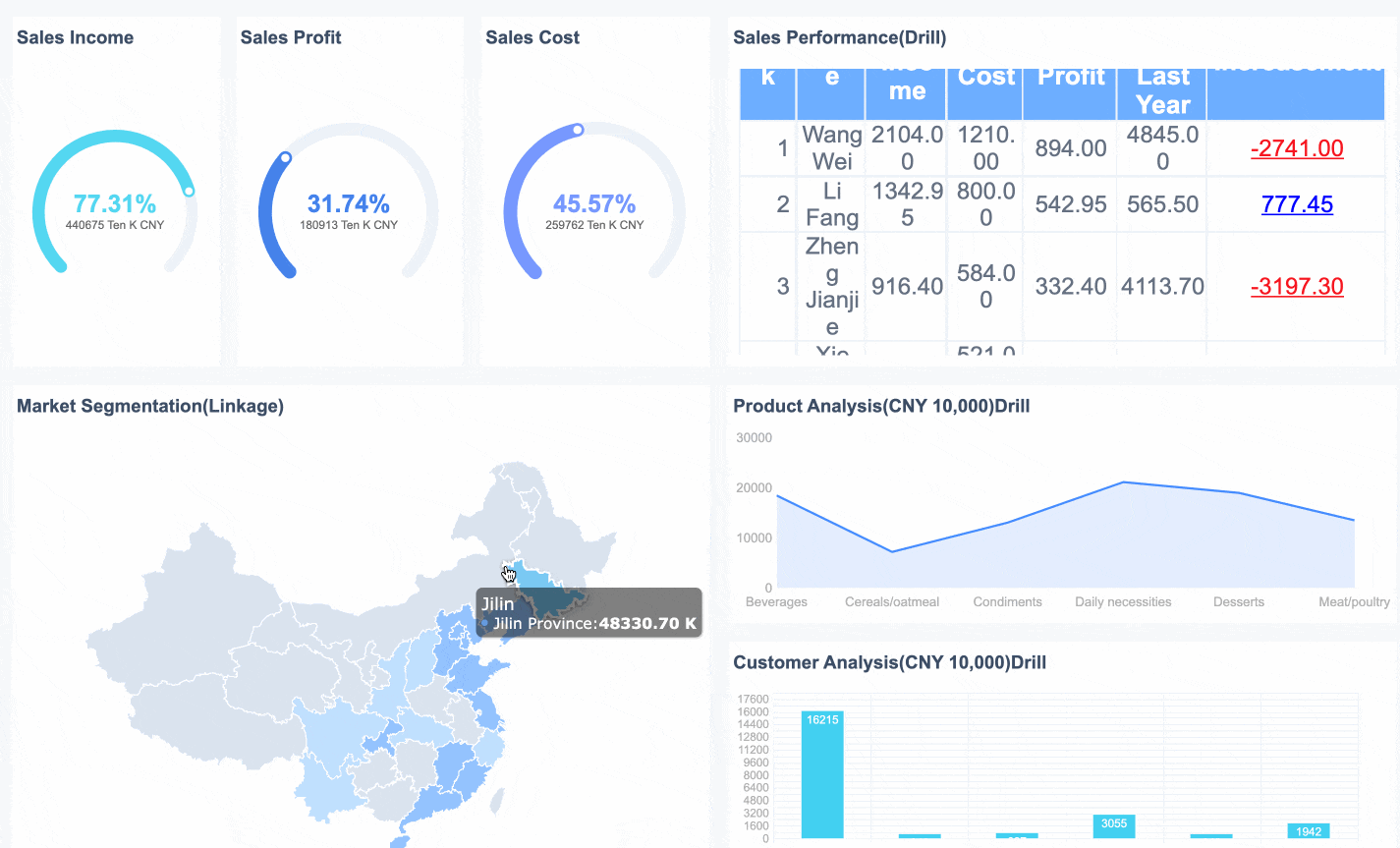
Retail Data Integration For Retail Intelligence
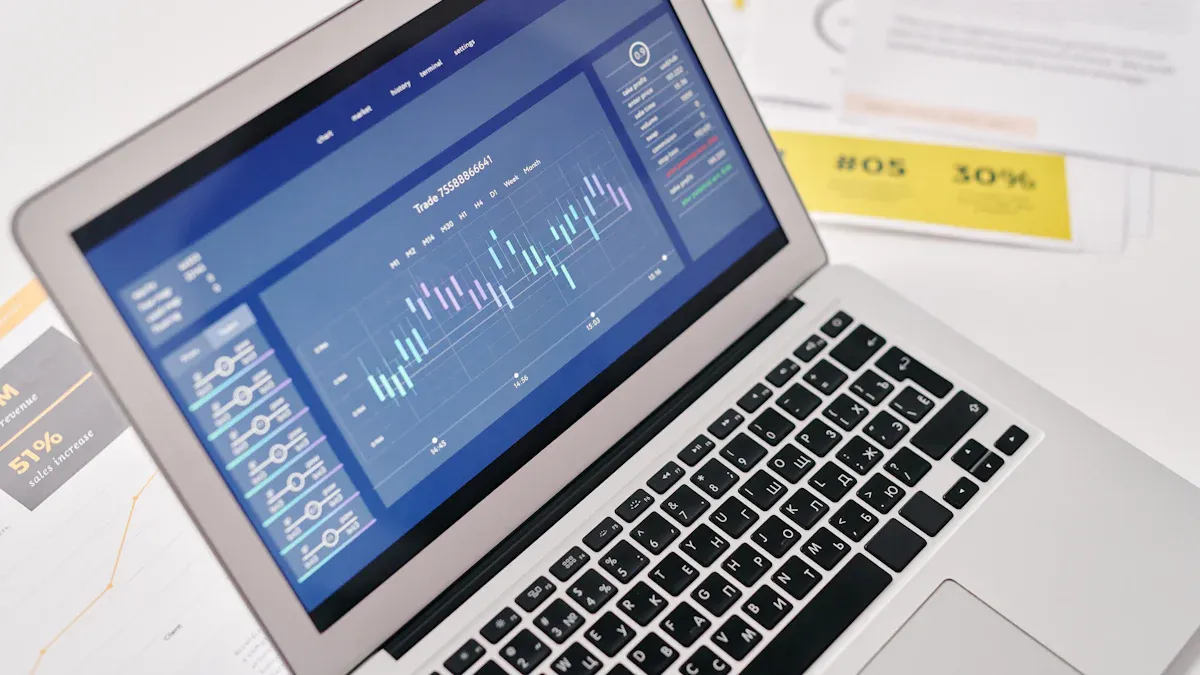
Connecting Retail Data Sources
You need to bring together information from many places to get the most value from retail intelligence. Retail businesses collect data from a wide range of sources. These include point-of-sale systems, e-commerce platforms, customer loyalty programs, social media channels, in-store sensors, inventory management systems, customer relationship management systems, competitor pricing data, seasonal sales forecasts, store foot traffic counters, and supplier databases. When you connect these sources, you gain a complete view of your retail operations. This unified approach helps you spot trends, understand customer behavior, and make better decisions.
FineBI helps you unify all your retail data. You can connect POS, CRM, ERP, and e-commerce systems in one platform. FineBI supports over 60 connectors, so you can bring together real-time data from every part of your retail business. This integration gives you a single source of truth for your retail intelligence needs.

Data Processing and Cleansing
Once you connect your retail data, you must ensure it is accurate and reliable. Clean data leads to better insights and smarter decisions. You should establish clear data cleaning guidelines and automate workflows to reduce errors. Continuous monitoring helps you catch issues early. Training your staff on data quality and documenting data lineage also support strong retail intelligence.
If you ignore data cleansing, you risk inaccurate analysis, duplication, missing values, and structural problems. These issues can lead to poor decisions and lost opportunities. Clean, reliable data lets you trust your retail insights and act with confidence.
Visualizing Retail Insights with FineBI
After processing your retail data, you need to turn it into actionable insights. FineBI makes this easy with self-service dashboards and real-time data visualization. You can drag and drop to create charts and reports that show key retail metrics. FineBI supports big data analytics and real-time data processing, so you always have the latest information.
For example, YangGuoFu, a leading retail brand, used FineBI to integrate data from 47 systems. This gave them real-time insights into supply chain management and customer preferences. As a result, they improved efficiency and grew their business. With FineBI, you can achieve similar results by transforming your retail data into real-time insights that drive success.
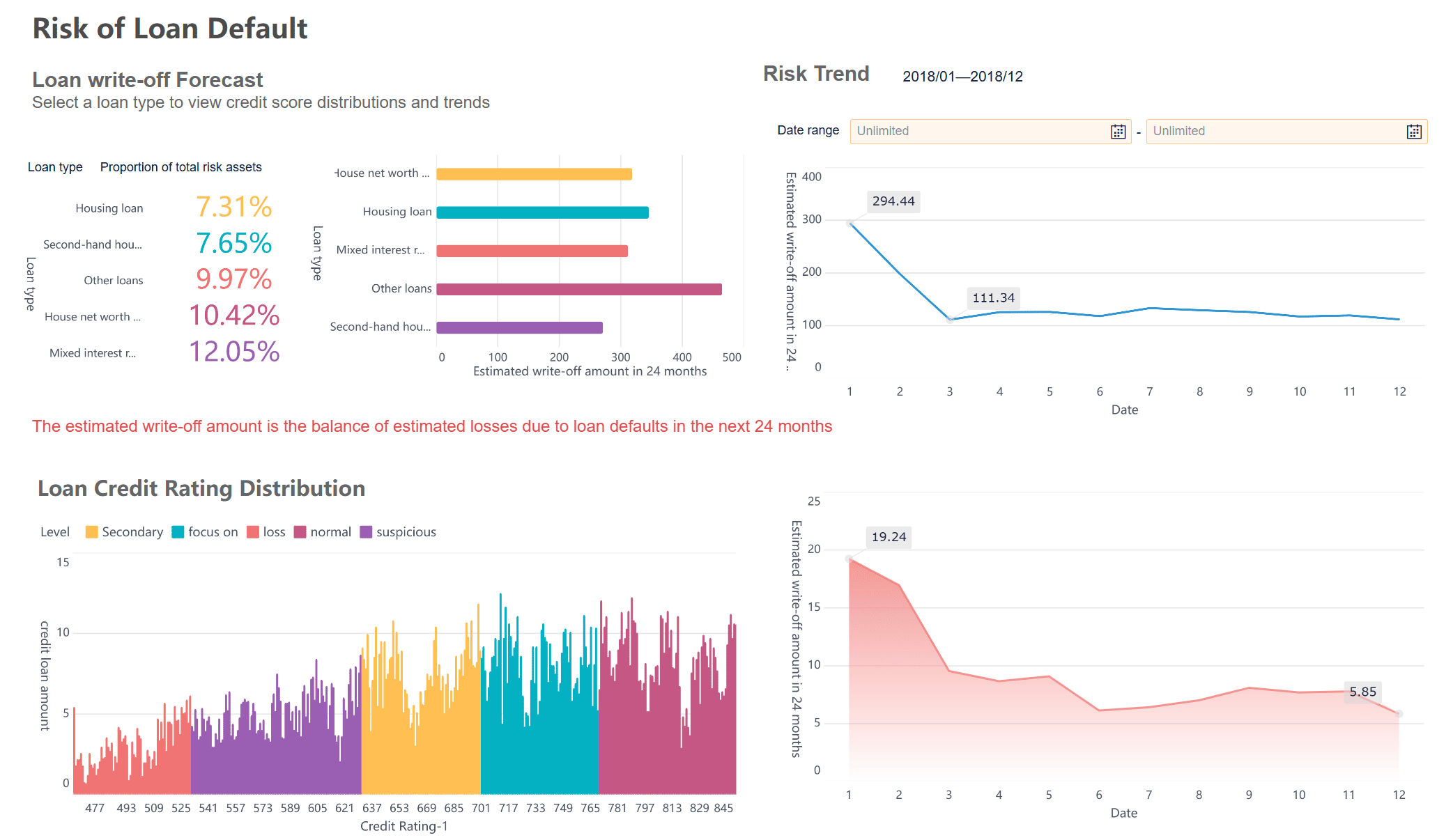
Retail Intelligence Benefits
Operational Efficiency with Retail Intelligence
You face constant pressure to improve operational efficiency in retail. Retail intelligence gives you the tools to analyze data from every part of your business. You can track employee performance, monitor sales per labor hour, and measure customer service ratings. These insights help you allocate resources more effectively and recognize high-performing staff. You make better staffing decisions by identifying peak hours and filling gaps without overspending.
Retail business intelligence platforms like FineBI provide real-time dashboards and KPI tracking. You see quantifiable assessments of your retail performance and make decisions based on facts. You detect trends early and act before issues grow. You allocate resources where they are needed most, improving productivity and reducing costs.
Tip: Use dashboards to monitor key metrics and spot inefficiencies quickly. This approach helps you respond to changes in consumer behavior and market demand.
Here is a table showing how retail business intelligence improves operational efficiency:
| Metric | Benefit |
|---|---|
| Revenue per labour hour | Helps in assessing productivity and optimizing labor costs. |
| Labour cost as a percentage of sales | Provides insight into cost management relative to sales performance. |
| Peak hours with staffing gaps | Enables better staffing decisions to meet customer demand without overspending. |
You also benefit from predictive analytics. You forecast demand more accurately, leading to fewer stockouts. You enhance cash flow through better inventory management and improve supplier relationships by aligning orders with customer needs.
Customer Experience and Engagement with Retail Intelligence
You know that customer experience drives loyalty and repeat purchases. Retail intelligence helps you understand consumer behavior and preferences. You use data to analyze every step of the customer journey, from browsing to checkout. You identify what motivates customers and what keeps them coming back.
Retail business intelligence platforms offer actionable insights into customer satisfaction and engagement. You track customer-related KPIs and use these insights to personalize shopping experiences. Technologies like augmented reality, virtual reality, and artificial intelligence create immersive environments and build trust. You differentiate your retail brand by leveraging these tools.
| Technology Type | Impact on Customer Experience |
|---|---|
| Augmented Reality (AR) | Enhances shopping experience by providing immersive environments. |
| Virtual Reality (VR) | Facilitates customer loyalty and advocacy through engaging interactions. |
| Artificial Intelligence (AI) | Improves customer trust and supports personalized shopping experiences. |
You use analytics to segment customers based on consumer behavior. You deliver targeted offers and improve engagement. You measure customer satisfaction and adjust your strategies to meet changing expectations. You gain customer insights that help you refine your marketing and sales strategies.
- Retail technologies significantly enhance customer experience and engagement.
- Understanding the customer journey requires consideration of retail technologies.
- Companies that effectively leverage technology can differentiate themselves in the market.
Inventory and Sales Optimization with Retail Intelligence
You need to optimize inventory and sales to stay competitive in retail. Retail intelligence platforms use predictive analytics to forecast demand and manage stock levels. You reduce risks associated with product launches by predicting demand in specific markets. You align inventory levels with actual demand, eliminating excess inventory and stockouts.
Predictive replenishment helps businesses align their inventory levels with actual demand, eliminating excess inventory and stockouts.
You achieve better inventory turnover rates and minimize carrying costs. You use data to analyze sales and margin information, adjusting your offerings to enhance profitability. You identify winning sales strategies and optimize marketing efforts to boost sales.
| Evidence Type | Description |
|---|---|
| Performance measurement | KPIs provide quantifiable assessments of retail performance against strategic objectives, ensuring decisions are based on facts. |
| Identifying trends | Regular KPI tracking helps detect emerging trends early, allowing retailers to act proactively on opportunities or issues. |
| Resource allocation | Dashboards reveal performance areas, enabling effective resource allocation based on demand and performance data. |
| Operational efficiency | KPIs identify inefficiencies, guiding targeted improvements that enhance productivity and reduce costs. |
| Customer insights | Tracking customer-related KPIs offers insights into behavior and satisfaction, informing better customer experience strategies. |
You benefit from AI-powered analytics. AI can reduce stockouts by up to 50% and decrease overstocking by up to 30%. AI continuously monitors inventory levels and sales data, providing accurate forecasts based on consumer behavior and market trends. You automate and optimize supply chain management, achieving significant efficiency gains and cost savings.
- Increased sales: Retail analytics helps you identify winning strategies and optimize marketing efforts.
- Improved profitability: You analyze sales and margin data to adjust offerings and enhance profit margins.
- More refined targeting for marketing campaigns: Better data analysis increases the effectiveness of your marketing.
- Enhanced customer experience and loyalty: Technology enables you to measure and improve customer interactions.
- Better staff scheduling: Predictive analytics aids in determining optimal staffing levels based on expected customer traffic.
You use retail business intelligence to transform raw data into actionable insights. You make informed decisions that drive growth, improve customer satisfaction, and optimize every aspect of your retail operations.

Implementing Retail Intelligence
Steps to Adoption
You can implement retail intelligence in your business by following a clear process. Start by defining your business goals. Focus on the outcomes you want to achieve, not just the technology. Next, assess your data readiness. Review the data in your POS and ERP systems to ensure it supports your objectives. Choose a business intelligence solution that fits both your technical and business needs. Integrate your chosen platform with core systems before moving forward. Begin with a small pilot project in one area of your retail operations. Monitor the results and scale up quickly if successful. Train your team and encourage a data-driven culture. Finally, set up ongoing governance and optimization. Establish metrics and monitor performance to ensure continuous improvement.
- Define business goals
- Assess data readiness
- Choose the right business intelligence approach
- Integrate in advance
- Start small, scale fast
- Drive adoption and change management
- Set up ongoing governance and optimization
Overcoming Retail Challenges
Retailers often face challenges when adopting retail intelligence. Integrating new technology can be difficult. Many retailers struggle with training staff and ensuring employee adoption. Data silos and outdated information can slow down your progress. Manual processes may lead to errors and inefficiencies. You can address these issues by creating a comprehensive AI roadmap that aligns with your business objectives. Implement robust data governance to maintain data quality. Invest in upskilling your employees to bridge any talent gaps.
| Challenge | Percentage of Respondents |
|---|---|
| Integrating new technology | 75% |
| Training staff on new technology | 51% |
| Employee awareness/adoption | 33% |
| Lack of vendor support | 22% |
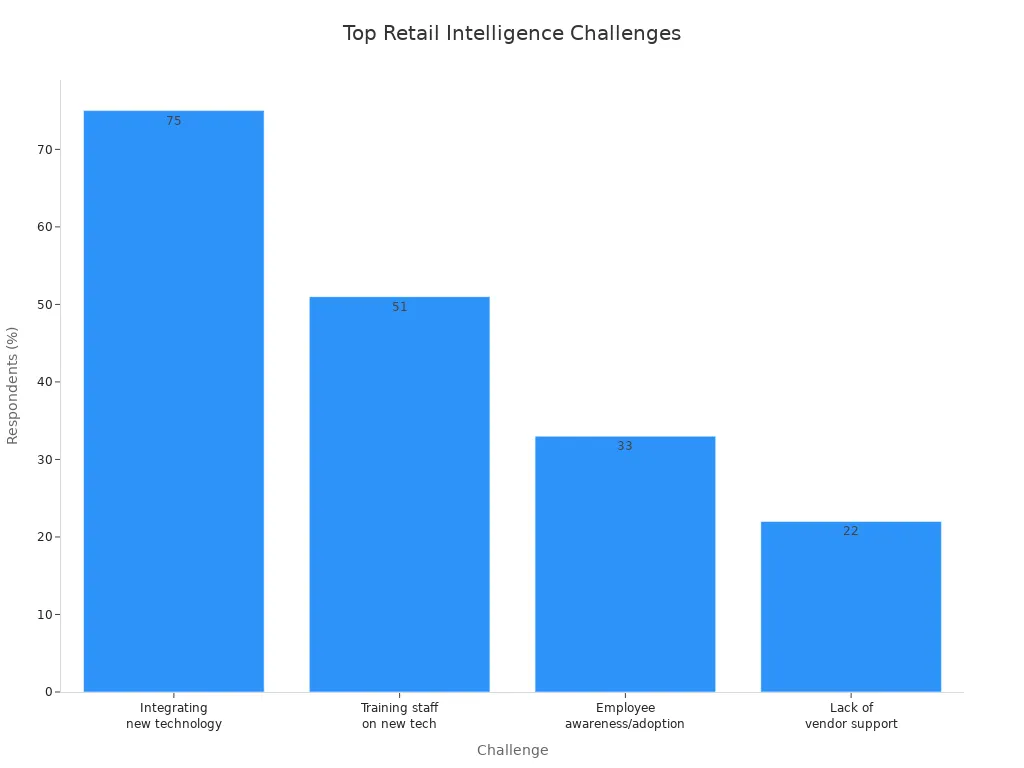
Note: User-friendly business intelligence solutions and strong training programs help you overcome these challenges and improve adoption.
Best Practices with FineBI
You can maximize the value of retail intelligence by following best practices with FineBI. Select a user-friendly business intelligence platform with intuitive dashboards. Clearly define your business insight targets and align them with your overall retail strategies. Ensure data integrity by establishing strong data governance procedures. Combine data from multiple sources using centralized data warehousing. FineBI helps you unify data, streamline analytics, and generate actionable insights for better decisions. This approach supports your strategic decisions and drives success in retail.
| Problem | Solution |
|---|---|
| Complex business intelligence tools | Choose user-friendly solutions with intuitive dashboards |
| Lack of clear business insight targets | Define and align targets with organizational goals |
| Incomplete or inaccurate data | Implement strong data governance procedures |
| Dispersed data from multiple systems | Combine data using centralized data warehousing |
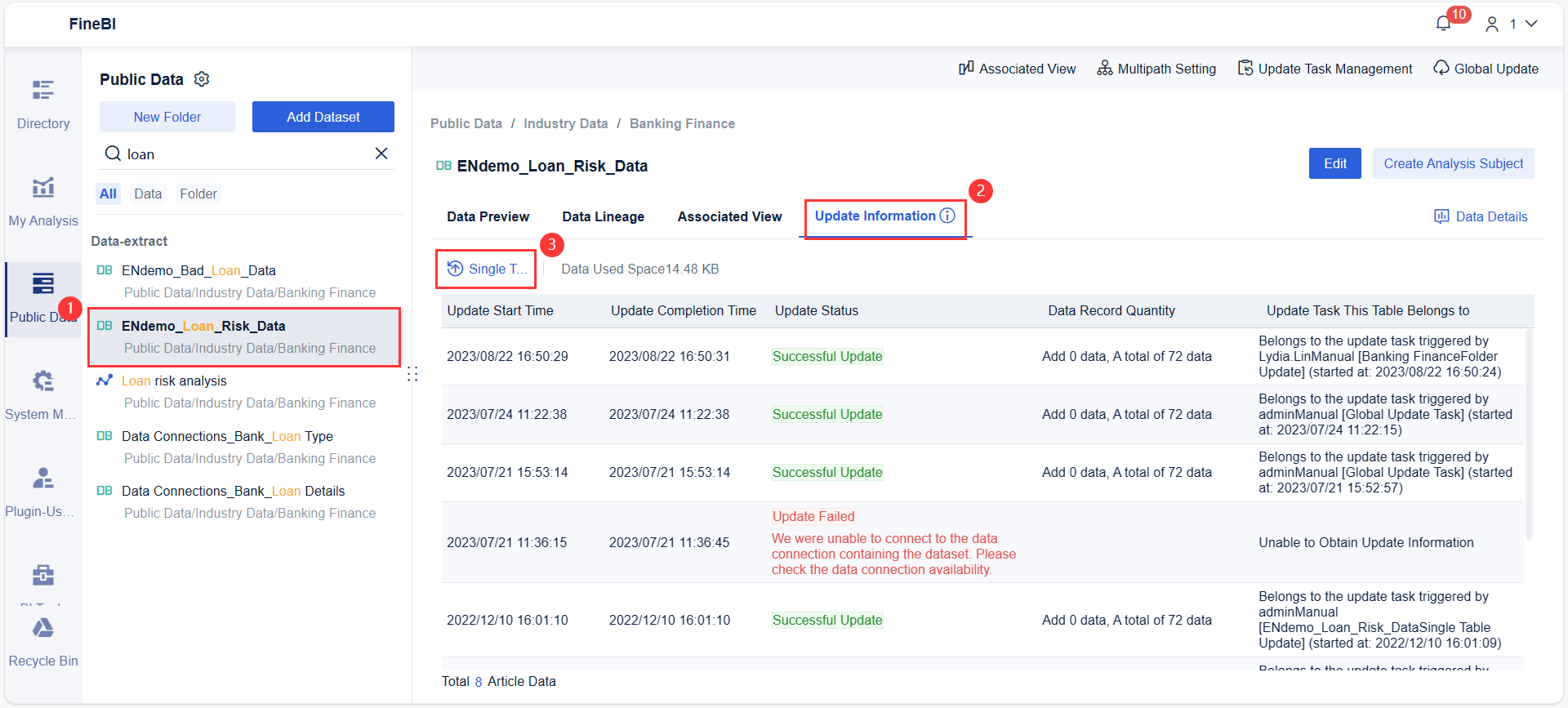
Future of Retail Intelligence
AI and Predictive Analytics in Retail Intelligence
You will see artificial intelligence and predictive analytics shape the future of retail intelligence. Retailers now use predictive models to forecast product demand, optimize inventory, and create dynamic pricing strategies. These tools help you adjust prices in real time based on market trends and customer behavior. AI-powered virtual assistants improve customer support and shopping experiences. In recent years, major companies have launched new AI tools to enhance shopping, such as Salesforce’s AI-powered features and AWS’s Nova Act for online retail tasks. Oracle’s Retail Suite now uses AI for assortment planning, showing how business intelligence platforms continue to evolve.
You can use predictive analytics to maintain optimal inventory levels and reduce stockouts. Personalized marketing campaigns, powered by predictive analytics, increase customer engagement and drive sales. Retailers also use AI to predict customer churn, allowing you to act before losing valuable customers. Sustainability forecasting and social sentiment analysis help you make eco-friendly decisions and understand consumer perceptions.
Personalization Trends in Retail Intelligence
Personalization stands at the center of modern retail intelligence. You can use machine learning to analyze data and create detailed shopper profiles. Automated marketing systems personalize content and timing, increasing engagement and sales. About 70% of consumers believe that a personalized customer experience is crucial when interacting with retail employees.
| Trend | Description |
|---|---|
| AI and Machine Learning | Help you understand consumer preferences and personalize shopping. |
| Predictive Analytics | Use historical data to forecast outcomes and optimize inventory and sales. |
| Prescriptive Analytics | Provide actionable recommendations for better decision-making. |
| Hyper-personalization | Deliver tailored content and experiences in real time. |
| Personalized Rewards | Offer incentives to boost loyalty and retention. |
| Privacy-conscious Personalization | Adapt strategies to comply with data privacy regulations. |
You can see how Amazon’s recommendation engine and Sephora’s virtual artist app use business intelligence to deliver innovative, personalized retail experiences.
FineBI Innovations for Retail Intelligence
FineBI continues to lead in retail intelligence by integrating advanced AI and predictive analytics. You can use FineBI to forecast demand, analyze market trends, and personalize customer interactions. The platform supports real-time data analysis, helping you respond quickly to changes in the retail landscape. FineBI’s conversational analytics, like FineChatBI, let you ask questions in plain language and get instant insights from your data.
Industry experts predict that by 2025, AI agents will play a crucial role in retail intelligence, enabling hyper-personalized shopping and real-time engagement. FineBI’s ongoing innovations ensure you stay ahead of emerging trends and make smarter decisions using business intelligence.
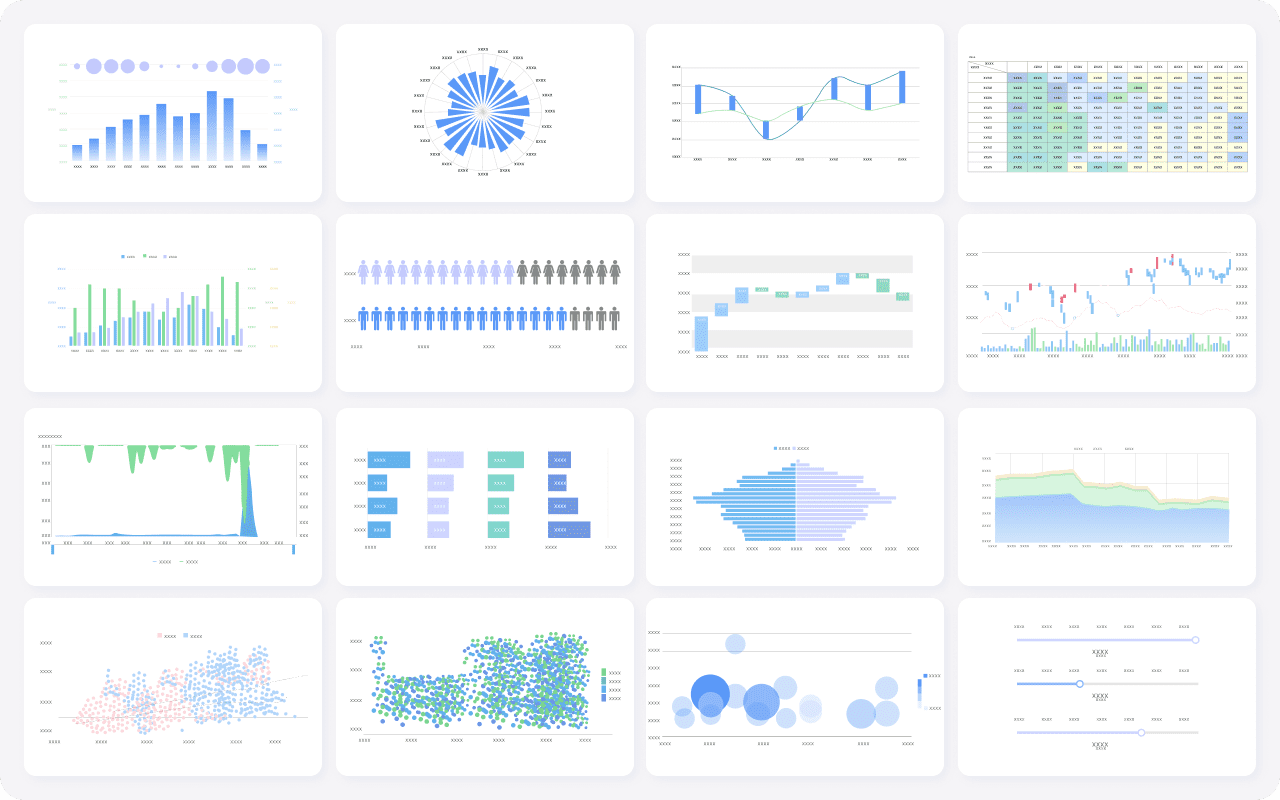
Retail intelligence drives your retail success by turning data into actionable insights. You gain a deeper understanding of competitors and market trends, which helps you make proactive decisions. FineBI empowers you to process data efficiently and spot business trends quickly.
- You simplify analysis and reduce technical barriers, letting your team focus on retail growth.
- Retailers who embrace data-driven strategies see benefits such as campaign performance analysis, merchandise assortment optimization, and process improvement.
| Benefit | Description |
|---|---|
| Store Layout | Data reveals how to improve product visibility and drive sales. |
| Fraud Detection | Analytics help identify unusual patterns and reduce losses. |
You stay ahead in retail by adopting solutions like FineBI and building a strong data culture.
Continue Reading about Retail Intelligence
Understanding Retail Management for the Modern Era
Retail Merchandising Secrets to Increase Sales
Unlocking Business Growth with Retail Analytics
How Retail Inventory Management Software Optimizes Store Performance
FAQ

The Author
Lewis
Senior Data Analyst at FanRuan
Related Articles

Top 10 Supply Chain Tracking Software for 2026
Compare the top supply chain tracking software for 2026 to boost visibility, automate workflows, and leverage AI analytics for smarter decisions.
Lewis
Dec 18, 2025

Top 10 Supply Chain Management Software for Small Businesses
See the top 10 supply chain management software comparison for small businesses in 2026. Compare features, pricing, and scalability to find your best fit.
Lewis
Dec 18, 2025

Top 10 Supply Chain Visibility Tools for 2025
Compare the top 10 supply chain visibility tools for 2025 to enhance real-time tracking, integration, and predictive analytics for efficient operations.
Lewis
Oct 29, 2025
